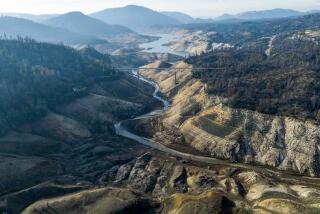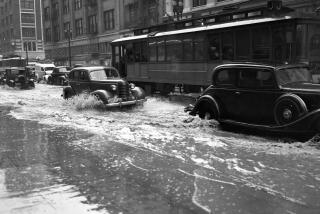Q&A: El Niño could bring disaster and drought relief to California
- Share via
How does El Niño work, and why might it bring rain and snow to California this winter? We answer your questions.
How might El Niño affect California?
There’s a favorable chance that this winter will be wetter than average in much of California -- from San Diego to San Francisco. The greatest chance for wet conditions is in Southern California, said Mike Halpert of the National Oceanic and Atmospheric Administration’s Climate Prediction Center.
But there’s only an equal chance of a wetter-than-average rainy season north of San Francisco, where much of the state’s water supply is collected and stored in giant reservoirs. California needs both rain and snow up there. Snow slowly melting from the mountains is essential to recharging our reservoirs when the skies turn dry later in the spring.
How can scientists make these forecasts about the winter half a year ahead of time?
We’ve had experience with El Niño before, a weather phenomenon characterized by the warming of Pacific Ocean waters west of Peru that causes changes in the atmosphere and can dramatically alter weather worldwide.
In the two strongest El Niños on record, 1982-83 and 1997-98, that has meant relentless storms pelting California.
What’s the latest on how El Niño is doing?
The ocean is getting hotter. On July 15, a key benchmark location in the Pacific Ocean was 3 degrees Fahrenheit above average. It’s very similar to the temperature reading on July 16, 1997, which was 3.2 degrees Fahrenheit above average.
So we’re matching the pace we saw in the summer of 1997?
Yes, at least for ocean temperatures along the equator. The summer of 1997 was the precursor to the strongest El Niño in the modern record.
What are other reasons scientists are so interested this year?
Winds along the Pacific Ocean at the equator typically move east to west. That’s why ocean water enjoyed by tourists on Indonesian beaches is so warm. Winds move warm water west, and the eastern Pacific Ocean’s surface along the equator is chilled as deep ocean water wells up.
In big El Niño years, so-called trade winds weaken, allowing the eastern Pacific Ocean to warm up more -- making El Niño even stronger.
Why do very strong El Niños bring more rain to California?
El Niño can bring something to Southern California called the subtropical jet stream.
This current of air usually runs over the jungles of southern Mexico and Nicaragua, a reason Central America has rain forests, said Bill Patzert, climatologist with NASA’s Jet Propulsion Laboratory in La Cañada Flintridge.
This subtropical jet stream has already shifted to the north, and is somewhat responsible for the devastating storms that pelted Texas and Oklahoma this spring and pushed those states out of drought, Patzert said.
“If it continues to warm up in the eastern Pacific, as we get into fall and winter, the subtropical jet stream could move across the southern tier of the United States,” Patzert said.
Only the south? What about Northern California?
El Niño needs to be particularly powerful to affect Northern California.
“This is not strong enough yet,” Patzert said. “The really big El Niños -- we’re not there yet -- can soak the whole state. But right now, it’s possible to get a lot of flooding and mudslides in the south. In Northern California, you could get below-normal rainfall and snowpack.
“So that’s why I’m not calling this a drought-buster yet,” Patzert said.
Could that change?
Yes. Ocean temperatures west of Peru could get even hotter than they are now.
“If this El Niño continues to strengthen, it would not surprise me to see ... all the lines extend farther north,” indicating a higher chance of a wetter winter even in the far northern section of California, Halpert said.
Does the 1997-98 El Niño offer a template to what our winter will look like?
There’s no guarantee this El Niño will act exactly like the one in 1997-98. Three or four months from now, things could be different. There are already a few differences that are giving experts like Halpert pause, like colder temperatures under the ocean’s surface and trade winds that haven’t locked into a convincing pattern as they did at this time in 1997.
Any other issues to consider?
The waters west of California and Mexico are also much warmer than average -- something that wasn’t seen in 1997, said Daniel Swain, climate scientist at Stanford University.
Did that play a role in the thunderstorms this weekend that made L.A. feel like Houston?
Yes. Those warm waters likely played a role in the powerful and rare thunderstorms that unleashed heavy rain in Southern California this past weekend. They came from the remnants of Hurricane Dolores.
Already, there has been an extraordinary number of active hurricanes so early this season in the eastern Pacific -- hurricanes that were fueled by the warmer ocean water, Swain said.
That warmer water helped keep the remains of Dolores more energetic as it slammed into Southern California. Normally, colder water would have weakened the ex-hurricane further before it arrived in California.
Can hurricanes hit California?
Surprise -- yes.
Hurricane-force winds hit San Diego on Oct. 2, 1858, and tropical storm-force winds were felt up the coast to Long Beach, according to scientists writing in the Bulletin of the American Meteorological Society. El Niño may have been a factor.
“Houses were unroofed and blown down, trees uprooted, and fences destroyed” in San Diego, according to one newspaper account. Another newspaper story reported severe damage at the San Pedro wharf, and heavy rains flooding streets and homes in Los Angeles.
A tropical storm struck Long Beach in September in the El Niño year of 1939, causing $2 million in damage.
And as El Niño developed in the summer of 1997, Hurricane Linda -- at the time the most powerful on record in the eastern Pacific -- threatened to menace Southern California and make landfall in San Diego as a weak hurricane or strong tropical storm. But the hurricane shifted direction and headed west to sea.
What does the presence of extraordinarily warm water off the California and Mexico coast mean, if we didn’t see this in 1997?
“This is not something we’ve seen in previous strong El Niños. This is a very unusual configuration,” Swain said. “The Pacific is in a really extreme configuration right now.
“What happens this winter is definitely going to be interesting,” Swain said.
Last question: Where did the term El Niño come from?
The name El Niño was first used by Peruvian fishermen who noticed warmer ocean water around Christmastime and gave the occurrence a Spanish name meaning “The Little Boy” that refers to the baby Jesus. It was only in the 1960s that scientists realized that the phenomenon wasn’t just something that affected the Peruvian coast, but a broad swath of the Pacific Ocean, according to William Kessler, a NOAA oceanographer.
Follow us on Twitter for more great explainers: @ronlin @thomas06037 @cartoonkahuna
MORE ON THE DROUGHT:
Unusually strong July rains offer a preview of a robust El Niño
State proposes $1.5-million fine of water district for improper diversions
Survival of Chatsworth Reservoir’s ‘ecology pond’ is debated
More to Read
Sign up for Essential California
The most important California stories and recommendations in your inbox every morning.
You may occasionally receive promotional content from the Los Angeles Times.












